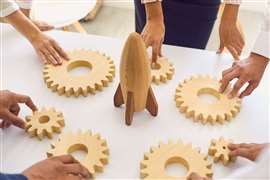Changing cranes
25 March 2008

Ask any of the major european crane suppliers what their backlog is like, and they'd most likely tell you they're sold out until the end of the year. This applies to many crawler, mobile and tower cranes, with some specific models unavailable for delivery until the second quarter of 2008.
It's a remarkable turnaround for an industry that was suffering a painful recession just four or five years ago, but the lack of manufacturing capacity and a shortage of key components are still sources of frustration for manufacturers, rental companies and contractors alike.
Steve Filipov, president of Terex Cranes, summed up the situation for many manufacturers by saying, “Our customers need out products right away, and we continue to struggle with the limited supply of certain components. We are working diligently to eliminate the production bottlenecks at our various locations and to better utilise the space we have.”
The flip side to the current supply problems is that they are opening the doors to other manufacturers, providing European buyers with more choice.
Among the more notable is Kato, which walked away from the European market during the last downturn. In January however, the Japanese company set up a joint venture with Italian crane manufacturer Autogru Rigo, which will see Kato's mobile cranes reintroduced to Europe.
Another returning name is Link-Belt. The US manufacturer has been largely absent from the European market for several years, but will exhibit its HTT-8690 90 ton (81,6 tonne) capacity truck crane at this month's Bauma exhibition. This appearance, along with others at national equipment shows later in the year seems to indicate the company is planning to renew its efforts in the European market.
Less familiar, but certainly serious about selling cranes in Europe, are several of the major Chinese manufacturers. The largest is XCMG, which made a staggering 7500 mobile cranes last year, giving it about a 50% share of the 13000 unit Chinese market. Exports however, are becoming an increasingly important part of all Chinese equipment makers' strategies
Zhang Yu Chun, general manager of XCMG's crane division, Xuzhou Highway Construction machinery told CE, “We exported about 800 cranes in 2006, which is about 95% of all the cranes exported from China. Excluding China, the global market for mobile cranes is about 7000 to 8000 units, so we have a market share of about 10%. We are aiming for about a 30% share of the world market.”
By the company's own admission, most of its export sales today are to less sophisticated markets than Europe, predominately the Middle East, Latin America and Africa, and its product focus has traditionally been on low capacity truck cranes. But that is also changing.
“In 2002 our largest crane was a 50 tonne capacity model. Now we have a 300 tonne All Terrain crane and we plan to build 400 and 500 tonne models. We plan to produce an 800 tonne capacity model within five years. In the crawler crane range we currently have a 450 tonne capacity model, and we plan to build 600 and 700 tonne models this year. By 2010 we plan to have a 1000 tonne crawler crane,” said Mr Zhang.
Both XCMG and Zoomlion, China's second largest crane manufacturer, have secured CE-mark certification for some of their mobile crane models, and are now taking the first steps in marketing their products in Europe, initially thorough independent distributors.
It is not just Chinese mobile cranes that are finding customers in Europe. Last year also saw the first tower crane made by Fushun Yongmao Construction Machinery delivered in Europe. The Yongmao STT293 was bought by London Tower Crane Hire & Sales from distributor Jin Long Europe, Fushun's European distributor. One of the key factors that secured the sale was Fushun's ability to deliver the crane within just eight weeks of receiving the order.
London is one of Europe's tower crane hotspots at the moments for both positive and negative reasons. On the downside, a recent spate of serious and (it would seem) inexcusable crane collapses – see ‘Tower trouble' – have focused attention on safety and inspection standards in the sector.
On the other hand, construction activity in London is on a high, and there are several high-profile high-rise projects in the pipeline for the city's central banking sector. London's narrow and twisting streets, combined with strict controls on over-sailing loads outside site perimeters have challenged manufacturers to come up with specialist luffing crane models.
Mobile News
But the tower crane sector is not the only part of the crane industry that's seeing significant innovation. Notwithstanding their production bottlenecks, most of the major manufacturers are launching significant new machines this year, many in the mobile crane segment.
Starting at the top of the heap, visitors to this month's Bauma exhibition will be able to see the most powerful telescopic mobile crane ever built on the Liebherr stand. With a lift capacity of 1200 tonnes, the nine-axle LTM 12000-9.1 is head and shoulders above any other crane of its type. It is also worth noting that at 100 m its telescopic boom will also be the biggest of its kind ever built.
The maximum hook height is 170 m with the longest boom and jib combination, but the crane will also be available in a short boom configuration with three of the seven telescopic sections removed for a 55 m boom.
Although the market for cranes of this size is tiny, with a handful of machines – if that – likely to be sold around the world each year, it seems big enough for other manufacturers besides Liebherr to develop similar machines. Terex-Demag is currently working on a prototype of its 1000 tonne capacity, nine-axle AC 1000/9 telescopic mobile, which is expected to be available in 2008.
According to Terex-Demag research and development director Klaus Meissner, the crane will have a load moment of around 3000 tonne-metres, and the maximum hook height will be 126 m.
Further down the weight categories, is Tadano Faun's new ATF 360G-6, which at 360 tonnes is the largest mobile crane it has ever built. It has a 60 m boom and six-axle chassis.
So, at the risk of stating the obvious, there is a clear trend in the market for cranes getting bigger. However, there is also a clear demand from crane rental companies and contractors for machines to be made more compact.
This is perhaps best illustrated in the 100 tonne capacity mobile crane sector, where the latest models come on four-axle carriers, rather than five. Having one less axle means such machines are more compact and manoeuvrable, which is particularly important in Europe's older cities, where streets are often narrow and twisting.
Liebherr was the first in the market with this type of machine in the shape of the LTM 1100-4.1, which offers a maximum lift height of 84 m. However, Grove, Tadano-Faun and Terex all have comparable four-axle models in their ranges now, with lift capacities from 90 to 100 tonnes.
Launches at Bauma include Grove's GMK4100, a 100 tonne capacity model with a 60 m, seven section main boom. Another feature worthy of note is the use of Grove's new ergonomic cab, which was unveiled at last year's Intermat exhibition, and which is being introduced as new models roll-out.
Similarly, Terex will be exhibiting the AC 100/4, which the company says has the strongest load chart in its class when configured with maximum counterweight. Underlining the need for manoeuvrability, the crane is just 2,55 m wide, even on large tyres.
Crawlers
Like the top end of the mobile crane sector, bigger is also better for crawler cranes. One of the key drivers of this is the wind generation market, where masts are getting taller and the turbines that sit at the top of them are getting bigger. Placing the latest generation of 5 MW turbines around 100 m or more in the air requires monstrous machines such as Liebherr's new 1350 tonne capacity LR 11350.
This offers a main boom of up to 114 m, with up to another 114 m of luffing jib for a maximum hook height of 223 m. But despite these huge dimensions, the crane can be broken down into components that weight less than 45 tonne and are no more than 3,5 m wide, for transportation purposes.
Another significant new heavy lifter is Kobelco's 550 tonne capacity SL6000. The maximum boom and luffing jib configuration gives it a 170 m hook height, and it is designed for heavy applications such as power station construction and the petrochemical industry.
But despite its impressive performance characteristics, a huge crane is not much use if it can't get to site easily. For this reason, and in common with many modern crawler cranes, the SL6000 is a modular design with ease of transport, assembly and dismantling in mind.
Further down the weight categories, there are new crawler cranes around the 200 tonne lift capacity mark becoming available. Yet another Bauma launch is Manitowoc's Model 14000, which offers 86 m of main boom, and a luffing jib that can take the hook height up to 114 m. Despite being new, Manitowoc says it has several dozen orders on its books, with delivery set to start in the middle of the year.
Link-Belt also has a comparable new model in the shape of 298 HSL, with a 230 US ton (208 tonne) lifting capacity. However, it remains to be seen if and when this model will be available in Europe, given that the US company is taking a greater interest in the European market.
Another crawler new to Europe is Hitachi-Sumitomo's SCX1200-2, a 120 tonne capacity lattice boom crawler.
New Concept
Having looked at the latest in tower, mobile and crawler cranes, it is perhaps appropriate to finish with a new machine that defies categorisation, with elements of all three crane types in its design. The GTK1100 from Manitowoc's Grove subsidiary is designed primarily for wind turbine, refinery and other work where maximum capacity at high reach is needed with easy transport and a quick set up time.
It features a multi-axle wheeled carrier, based on a semi trailer design. Mounted on this is a vertical telescopic mast topped with a luffing telescopic boom that resembles the upper from an all terrain mobile crane. The six section vertical tower extends to a height of 81 m and the telescopic luffing boom mounted on top increases the maximum hook height to more than 140 m. Preliminary figures suggest the GTK will lift 70 tonnes to a height of more than 120 m.
It stands on a four-outrigger cross base and fast set up time in a small space are the primary characteristics. Transporting the crane will require just four trailers instead of up to 25 for machines of similar capabilities. The first model to be manufactured has been sold to German rental company Wiesbauer, and it will be on display at Bauma in the company's colours.
Outlook
As long as the world market – because crane manufacturing is a global business – continues to boom, the problem of long waiting times seems likely to be a continuing source of frustration for crane buyers and users. Having said that, the bottlenecks will be overcome as production capacities increase for both manufacturers and the component suppliers they depend on.
On the positive side, the current boom has clearly fuelled a huge investment in research & development, which has already brought new and better cranes to the European market. The buoyancy of the market is also encouraging more manufacturers to look at supplying in Europe, providing more options and more availability when it comes to buying cranes. The increased choice and competition should be good news for crane rental specialists and contractors alike.




